Change Management in Nokia Company: A Case Study
VerifiedAdded on 2023/06/10
|15
|4052
|222
AI Summary
This report discusses the facets of change management using Nokia Company as a case study. It explains the steps of change implementation, ethical dilemmas, management of resistance to change, and the impact of organizational culture on change.
Contribute Materials
Your contribution can guide someone’s learning journey. Share your
documents today.
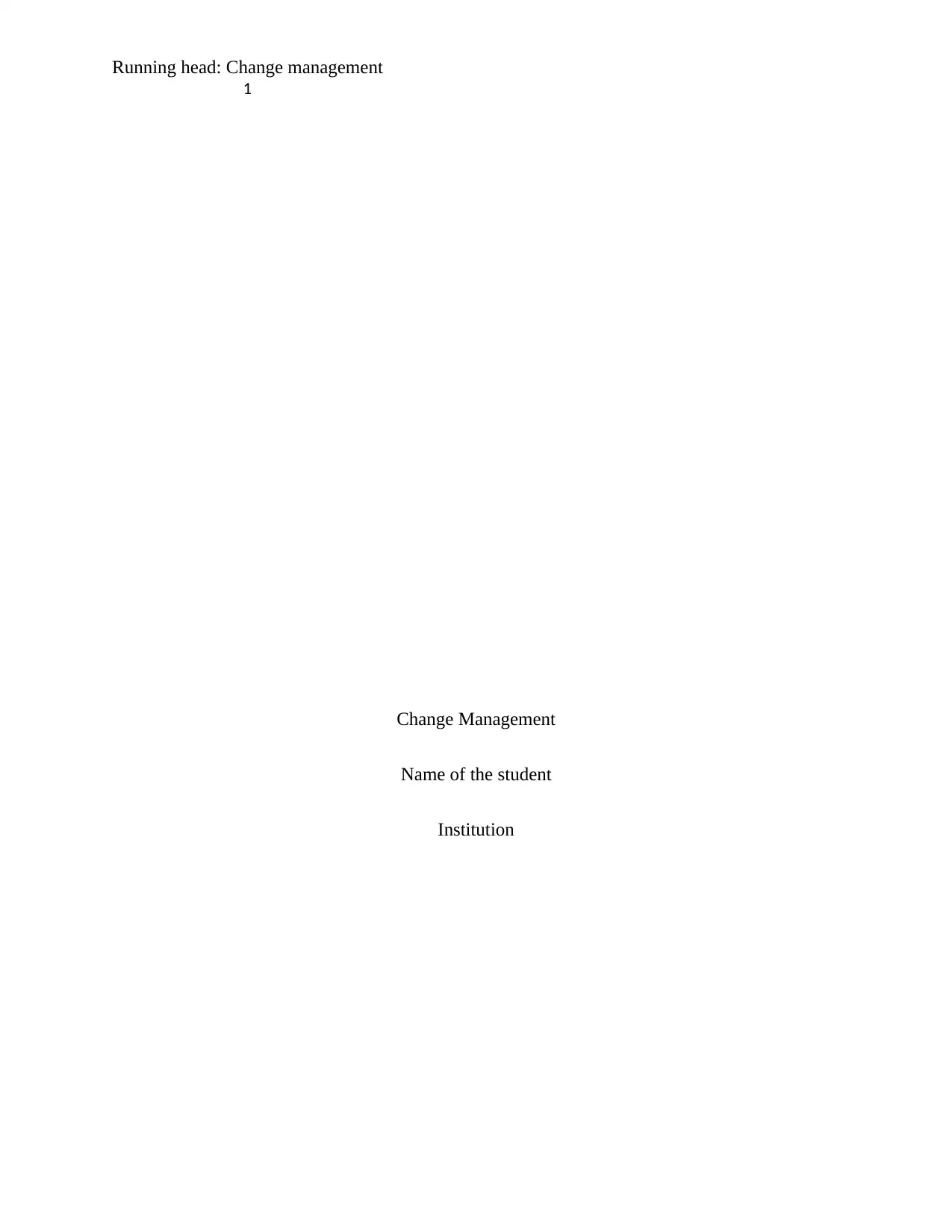
Running head: Change management
1
Change Management
Name of the student
Institution
1
Change Management
Name of the student
Institution
Secure Best Marks with AI Grader
Need help grading? Try our AI Grader for instant feedback on your assignments.
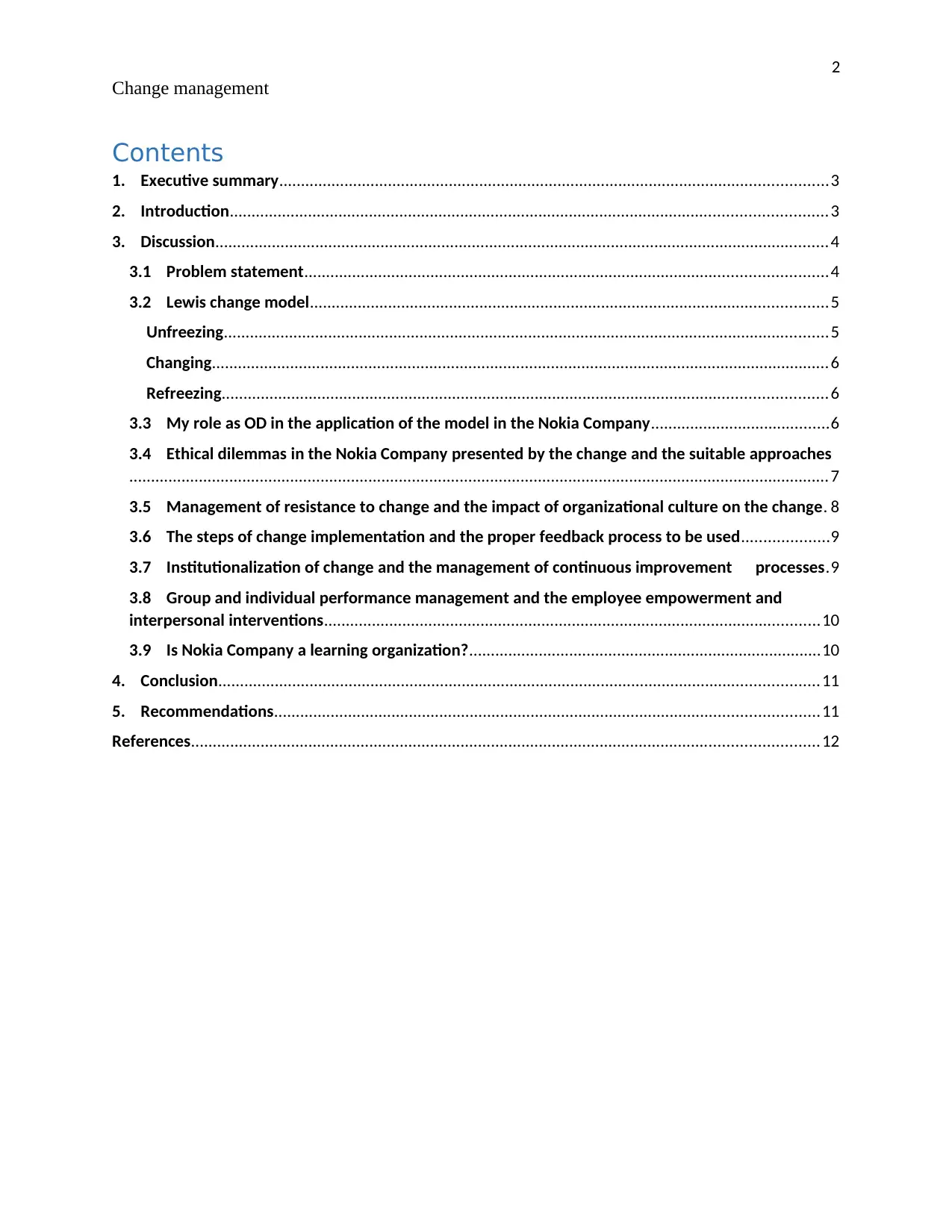
2
Change management
Contents
1. Executive summary..............................................................................................................................3
2. Introduction.........................................................................................................................................3
3. Discussion.............................................................................................................................................4
3.1 Problem statement........................................................................................................................4
3.2 Lewis change model.......................................................................................................................5
Unfreezing...........................................................................................................................................5
Changing..............................................................................................................................................6
Refreezing...........................................................................................................................................6
3.3 My role as OD in the application of the model in the Nokia Company.........................................6
3.4 Ethical dilemmas in the Nokia Company presented by the change and the suitable approaches
.................................................................................................................................................................7
3.5 Management of resistance to change and the impact of organizational culture on the change. 8
3.6 The steps of change implementation and the proper feedback process to be used....................9
3.7 Institutionalization of change and the management of continuous improvement processes.9
3.8 Group and individual performance management and the employee empowerment and
interpersonal interventions..................................................................................................................10
3.9 Is Nokia Company a learning organization?.................................................................................10
4. Conclusion..........................................................................................................................................11
5. Recommendations.............................................................................................................................11
References................................................................................................................................................12
Change management
Contents
1. Executive summary..............................................................................................................................3
2. Introduction.........................................................................................................................................3
3. Discussion.............................................................................................................................................4
3.1 Problem statement........................................................................................................................4
3.2 Lewis change model.......................................................................................................................5
Unfreezing...........................................................................................................................................5
Changing..............................................................................................................................................6
Refreezing...........................................................................................................................................6
3.3 My role as OD in the application of the model in the Nokia Company.........................................6
3.4 Ethical dilemmas in the Nokia Company presented by the change and the suitable approaches
.................................................................................................................................................................7
3.5 Management of resistance to change and the impact of organizational culture on the change. 8
3.6 The steps of change implementation and the proper feedback process to be used....................9
3.7 Institutionalization of change and the management of continuous improvement processes.9
3.8 Group and individual performance management and the employee empowerment and
interpersonal interventions..................................................................................................................10
3.9 Is Nokia Company a learning organization?.................................................................................10
4. Conclusion..........................................................................................................................................11
5. Recommendations.............................................................................................................................11
References................................................................................................................................................12
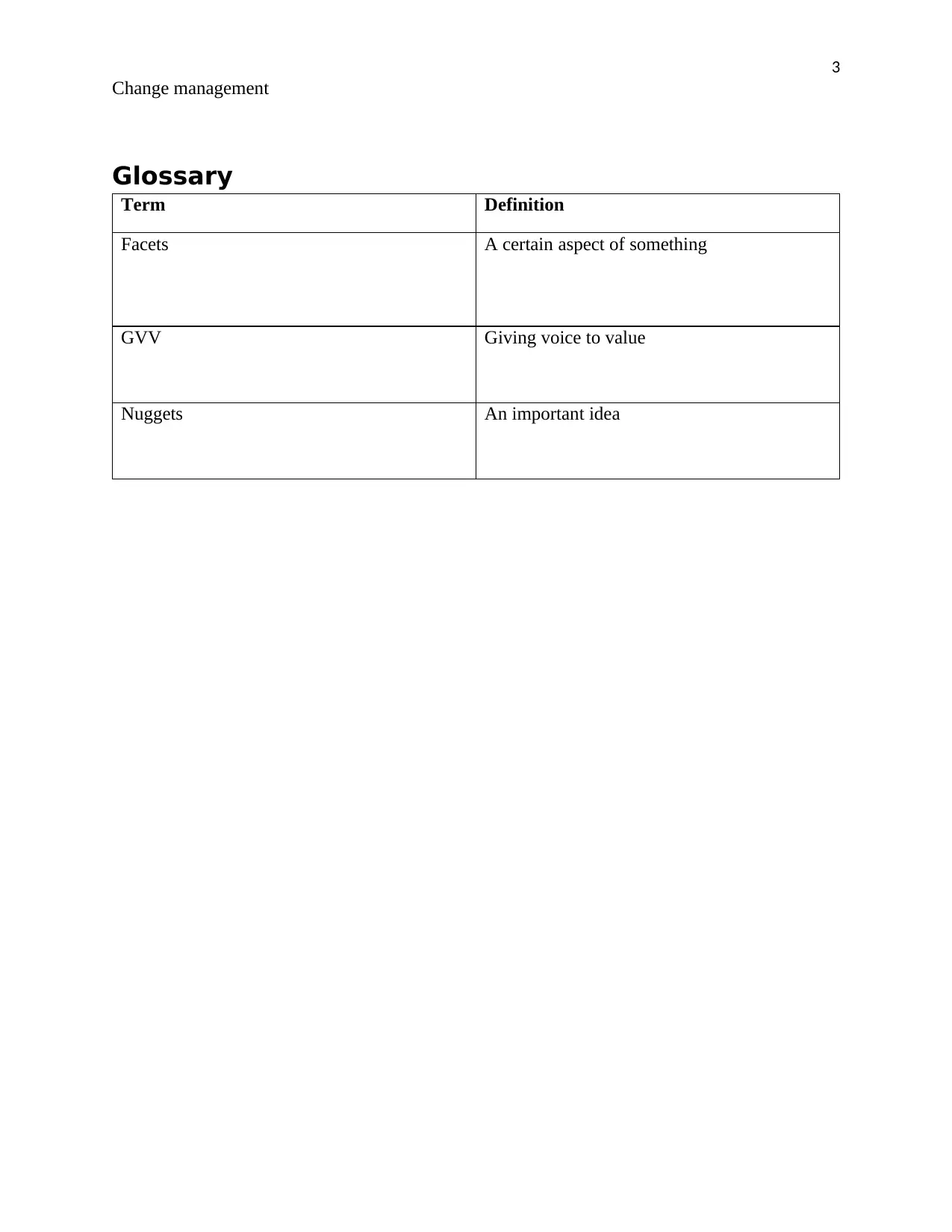
3
Change management
Glossary
Term Definition
Facets A certain aspect of something
GVV Giving voice to value
Nuggets An important idea
Change management
Glossary
Term Definition
Facets A certain aspect of something
GVV Giving voice to value
Nuggets An important idea
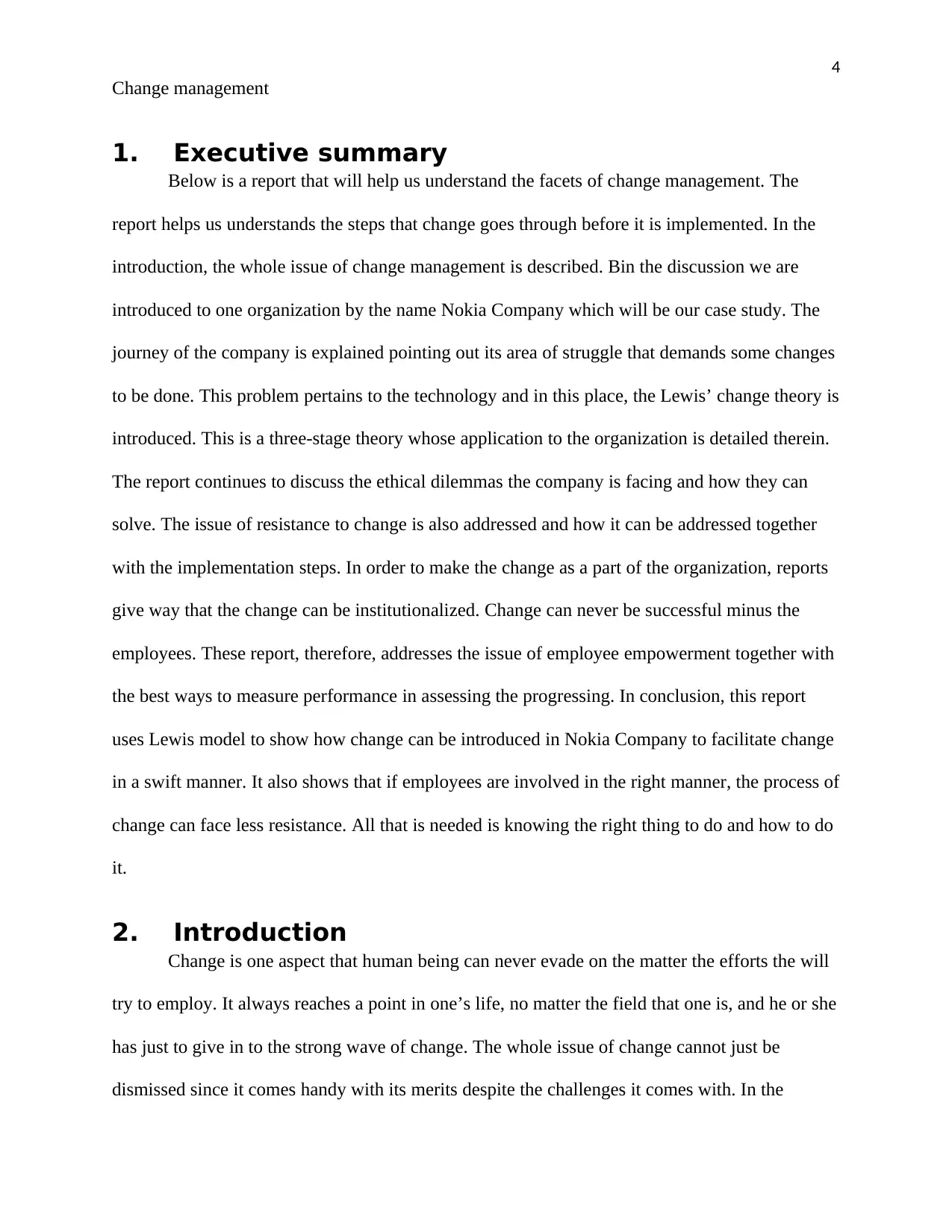
4
Change management
1. Executive summary
Below is a report that will help us understand the facets of change management. The
report helps us understands the steps that change goes through before it is implemented. In the
introduction, the whole issue of change management is described. Bin the discussion we are
introduced to one organization by the name Nokia Company which will be our case study. The
journey of the company is explained pointing out its area of struggle that demands some changes
to be done. This problem pertains to the technology and in this place, the Lewis’ change theory is
introduced. This is a three-stage theory whose application to the organization is detailed therein.
The report continues to discuss the ethical dilemmas the company is facing and how they can
solve. The issue of resistance to change is also addressed and how it can be addressed together
with the implementation steps. In order to make the change as a part of the organization, reports
give way that the change can be institutionalized. Change can never be successful minus the
employees. These report, therefore, addresses the issue of employee empowerment together with
the best ways to measure performance in assessing the progressing. In conclusion, this report
uses Lewis model to show how change can be introduced in Nokia Company to facilitate change
in a swift manner. It also shows that if employees are involved in the right manner, the process of
change can face less resistance. All that is needed is knowing the right thing to do and how to do
it.
2. Introduction
Change is one aspect that human being can never evade on the matter the efforts the will
try to employ. It always reaches a point in one’s life, no matter the field that one is, and he or she
has just to give in to the strong wave of change. The whole issue of change cannot just be
dismissed since it comes handy with its merits despite the challenges it comes with. In the
Change management
1. Executive summary
Below is a report that will help us understand the facets of change management. The
report helps us understands the steps that change goes through before it is implemented. In the
introduction, the whole issue of change management is described. Bin the discussion we are
introduced to one organization by the name Nokia Company which will be our case study. The
journey of the company is explained pointing out its area of struggle that demands some changes
to be done. This problem pertains to the technology and in this place, the Lewis’ change theory is
introduced. This is a three-stage theory whose application to the organization is detailed therein.
The report continues to discuss the ethical dilemmas the company is facing and how they can
solve. The issue of resistance to change is also addressed and how it can be addressed together
with the implementation steps. In order to make the change as a part of the organization, reports
give way that the change can be institutionalized. Change can never be successful minus the
employees. These report, therefore, addresses the issue of employee empowerment together with
the best ways to measure performance in assessing the progressing. In conclusion, this report
uses Lewis model to show how change can be introduced in Nokia Company to facilitate change
in a swift manner. It also shows that if employees are involved in the right manner, the process of
change can face less resistance. All that is needed is knowing the right thing to do and how to do
it.
2. Introduction
Change is one aspect that human being can never evade on the matter the efforts the will
try to employ. It always reaches a point in one’s life, no matter the field that one is, and he or she
has just to give in to the strong wave of change. The whole issue of change cannot just be
dismissed since it comes handy with its merits despite the challenges it comes with. In the
Paraphrase This Document
Need a fresh take? Get an instant paraphrase of this document with our AI Paraphraser
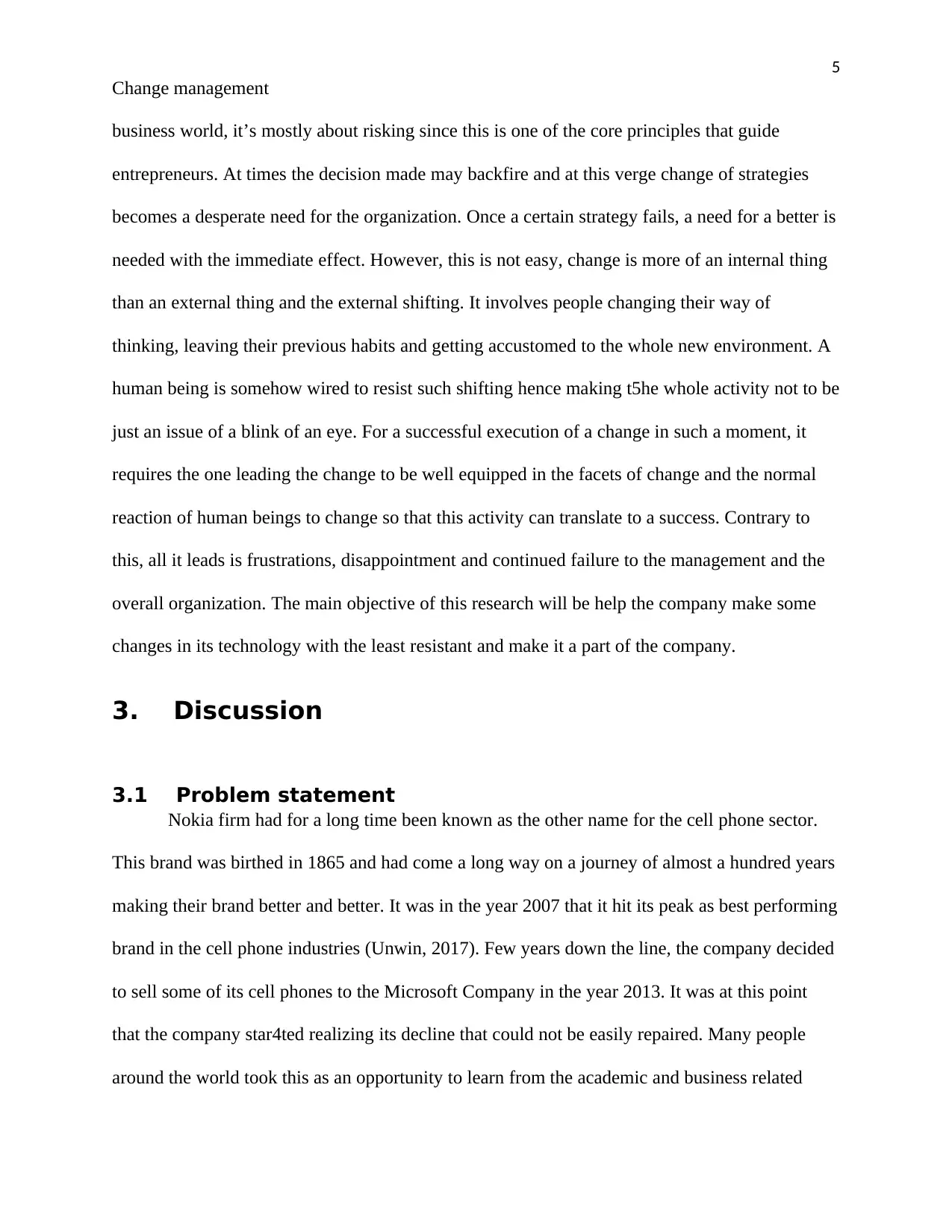
5
Change management
business world, it’s mostly about risking since this is one of the core principles that guide
entrepreneurs. At times the decision made may backfire and at this verge change of strategies
becomes a desperate need for the organization. Once a certain strategy fails, a need for a better is
needed with the immediate effect. However, this is not easy, change is more of an internal thing
than an external thing and the external shifting. It involves people changing their way of
thinking, leaving their previous habits and getting accustomed to the whole new environment. A
human being is somehow wired to resist such shifting hence making t5he whole activity not to be
just an issue of a blink of an eye. For a successful execution of a change in such a moment, it
requires the one leading the change to be well equipped in the facets of change and the normal
reaction of human beings to change so that this activity can translate to a success. Contrary to
this, all it leads is frustrations, disappointment and continued failure to the management and the
overall organization. The main objective of this research will be help the company make some
changes in its technology with the least resistant and make it a part of the company.
3. Discussion
3.1 Problem statement
Nokia firm had for a long time been known as the other name for the cell phone sector.
This brand was birthed in 1865 and had come a long way on a journey of almost a hundred years
making their brand better and better. It was in the year 2007 that it hit its peak as best performing
brand in the cell phone industries (Unwin, 2017). Few years down the line, the company decided
to sell some of its cell phones to the Microsoft Company in the year 2013. It was at this point
that the company star4ted realizing its decline that could not be easily repaired. Many people
around the world took this as an opportunity to learn from the academic and business related
Change management
business world, it’s mostly about risking since this is one of the core principles that guide
entrepreneurs. At times the decision made may backfire and at this verge change of strategies
becomes a desperate need for the organization. Once a certain strategy fails, a need for a better is
needed with the immediate effect. However, this is not easy, change is more of an internal thing
than an external thing and the external shifting. It involves people changing their way of
thinking, leaving their previous habits and getting accustomed to the whole new environment. A
human being is somehow wired to resist such shifting hence making t5he whole activity not to be
just an issue of a blink of an eye. For a successful execution of a change in such a moment, it
requires the one leading the change to be well equipped in the facets of change and the normal
reaction of human beings to change so that this activity can translate to a success. Contrary to
this, all it leads is frustrations, disappointment and continued failure to the management and the
overall organization. The main objective of this research will be help the company make some
changes in its technology with the least resistant and make it a part of the company.
3. Discussion
3.1 Problem statement
Nokia firm had for a long time been known as the other name for the cell phone sector.
This brand was birthed in 1865 and had come a long way on a journey of almost a hundred years
making their brand better and better. It was in the year 2007 that it hit its peak as best performing
brand in the cell phone industries (Unwin, 2017). Few years down the line, the company decided
to sell some of its cell phones to the Microsoft Company in the year 2013. It was at this point
that the company star4ted realizing its decline that could not be easily repaired. Many people
around the world took this as an opportunity to learn from the academic and business related
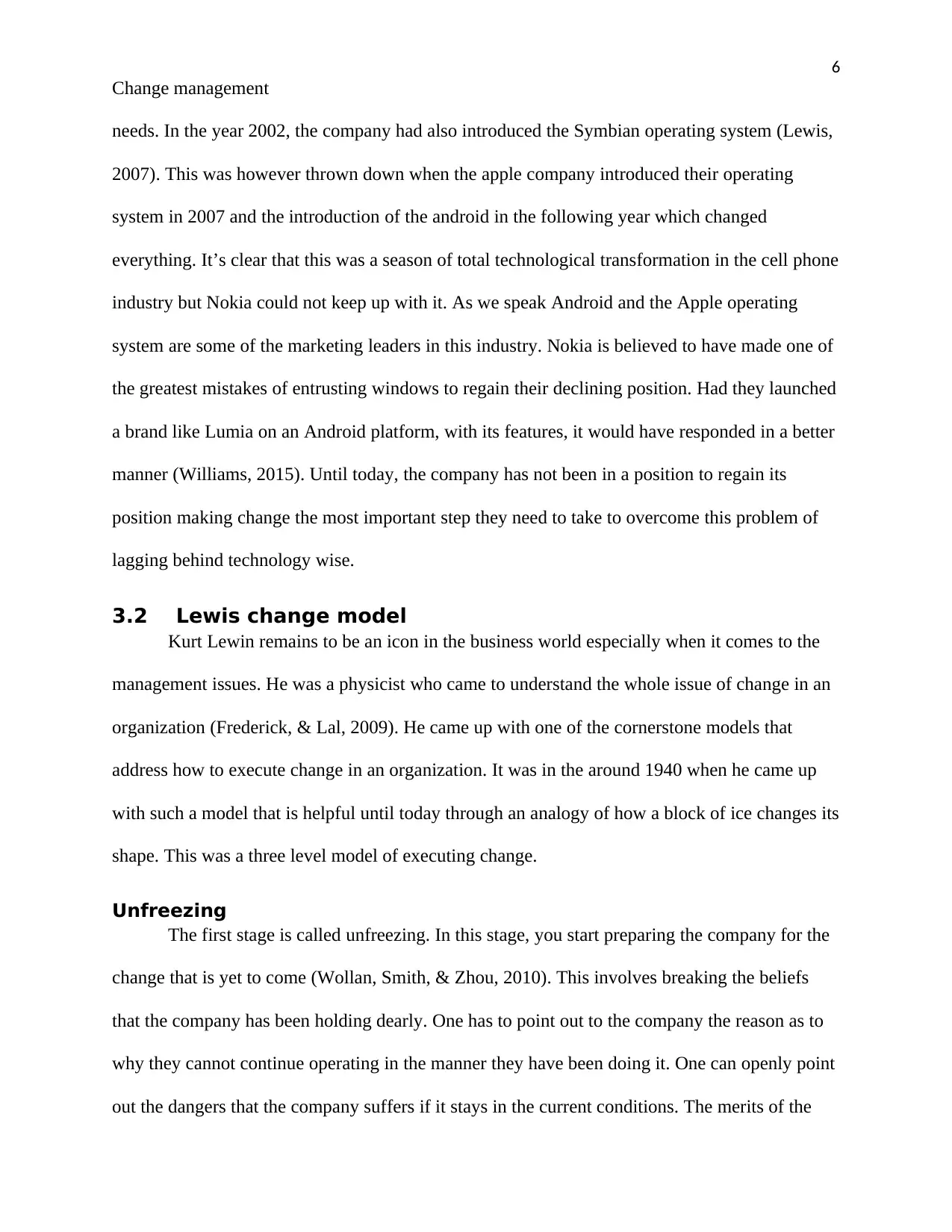
6
Change management
needs. In the year 2002, the company had also introduced the Symbian operating system (Lewis,
2007). This was however thrown down when the apple company introduced their operating
system in 2007 and the introduction of the android in the following year which changed
everything. It’s clear that this was a season of total technological transformation in the cell phone
industry but Nokia could not keep up with it. As we speak Android and the Apple operating
system are some of the marketing leaders in this industry. Nokia is believed to have made one of
the greatest mistakes of entrusting windows to regain their declining position. Had they launched
a brand like Lumia on an Android platform, with its features, it would have responded in a better
manner (Williams, 2015). Until today, the company has not been in a position to regain its
position making change the most important step they need to take to overcome this problem of
lagging behind technology wise.
3.2 Lewis change model
Kurt Lewin remains to be an icon in the business world especially when it comes to the
management issues. He was a physicist who came to understand the whole issue of change in an
organization (Frederick, & Lal, 2009). He came up with one of the cornerstone models that
address how to execute change in an organization. It was in the around 1940 when he came up
with such a model that is helpful until today through an analogy of how a block of ice changes its
shape. This was a three level model of executing change.
Unfreezing
The first stage is called unfreezing. In this stage, you start preparing the company for the
change that is yet to come (Wollan, Smith, & Zhou, 2010). This involves breaking the beliefs
that the company has been holding dearly. One has to point out to the company the reason as to
why they cannot continue operating in the manner they have been doing it. One can openly point
out the dangers that the company suffers if it stays in the current conditions. The merits of the
Change management
needs. In the year 2002, the company had also introduced the Symbian operating system (Lewis,
2007). This was however thrown down when the apple company introduced their operating
system in 2007 and the introduction of the android in the following year which changed
everything. It’s clear that this was a season of total technological transformation in the cell phone
industry but Nokia could not keep up with it. As we speak Android and the Apple operating
system are some of the marketing leaders in this industry. Nokia is believed to have made one of
the greatest mistakes of entrusting windows to regain their declining position. Had they launched
a brand like Lumia on an Android platform, with its features, it would have responded in a better
manner (Williams, 2015). Until today, the company has not been in a position to regain its
position making change the most important step they need to take to overcome this problem of
lagging behind technology wise.
3.2 Lewis change model
Kurt Lewin remains to be an icon in the business world especially when it comes to the
management issues. He was a physicist who came to understand the whole issue of change in an
organization (Frederick, & Lal, 2009). He came up with one of the cornerstone models that
address how to execute change in an organization. It was in the around 1940 when he came up
with such a model that is helpful until today through an analogy of how a block of ice changes its
shape. This was a three level model of executing change.
Unfreezing
The first stage is called unfreezing. In this stage, you start preparing the company for the
change that is yet to come (Wollan, Smith, & Zhou, 2010). This involves breaking the beliefs
that the company has been holding dearly. One has to point out to the company the reason as to
why they cannot continue operating in the manner they have been doing it. One can openly point
out the dangers that the company suffers if it stays in the current conditions. The merits of the
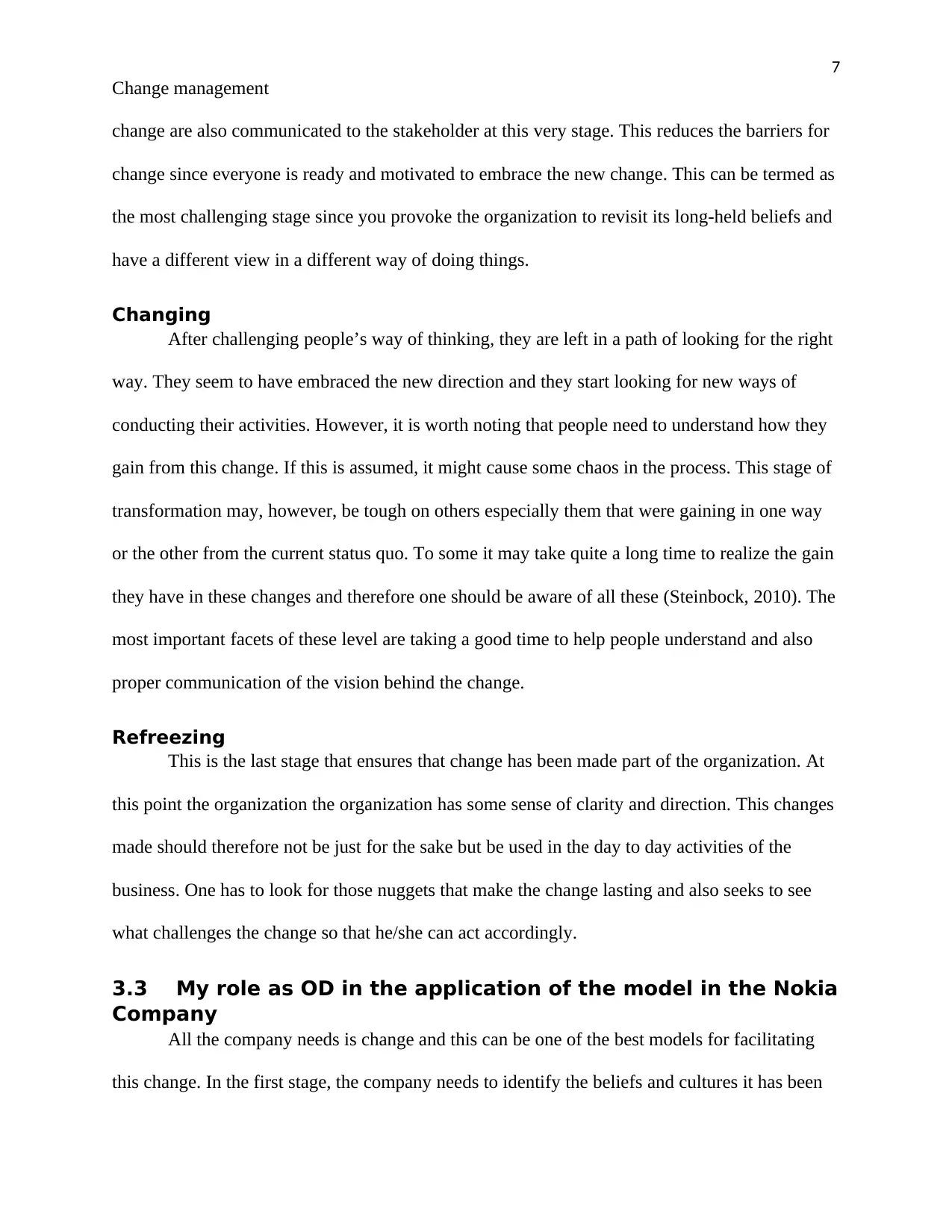
7
Change management
change are also communicated to the stakeholder at this very stage. This reduces the barriers for
change since everyone is ready and motivated to embrace the new change. This can be termed as
the most challenging stage since you provoke the organization to revisit its long-held beliefs and
have a different view in a different way of doing things.
Changing
After challenging people’s way of thinking, they are left in a path of looking for the right
way. They seem to have embraced the new direction and they start looking for new ways of
conducting their activities. However, it is worth noting that people need to understand how they
gain from this change. If this is assumed, it might cause some chaos in the process. This stage of
transformation may, however, be tough on others especially them that were gaining in one way
or the other from the current status quo. To some it may take quite a long time to realize the gain
they have in these changes and therefore one should be aware of all these (Steinbock, 2010). The
most important facets of these level are taking a good time to help people understand and also
proper communication of the vision behind the change.
Refreezing
This is the last stage that ensures that change has been made part of the organization. At
this point the organization the organization has some sense of clarity and direction. This changes
made should therefore not be just for the sake but be used in the day to day activities of the
business. One has to look for those nuggets that make the change lasting and also seeks to see
what challenges the change so that he/she can act accordingly.
3.3 My role as OD in the application of the model in the Nokia
Company
All the company needs is change and this can be one of the best models for facilitating
this change. In the first stage, the company needs to identify the beliefs and cultures it has been
Change management
change are also communicated to the stakeholder at this very stage. This reduces the barriers for
change since everyone is ready and motivated to embrace the new change. This can be termed as
the most challenging stage since you provoke the organization to revisit its long-held beliefs and
have a different view in a different way of doing things.
Changing
After challenging people’s way of thinking, they are left in a path of looking for the right
way. They seem to have embraced the new direction and they start looking for new ways of
conducting their activities. However, it is worth noting that people need to understand how they
gain from this change. If this is assumed, it might cause some chaos in the process. This stage of
transformation may, however, be tough on others especially them that were gaining in one way
or the other from the current status quo. To some it may take quite a long time to realize the gain
they have in these changes and therefore one should be aware of all these (Steinbock, 2010). The
most important facets of these level are taking a good time to help people understand and also
proper communication of the vision behind the change.
Refreezing
This is the last stage that ensures that change has been made part of the organization. At
this point the organization the organization has some sense of clarity and direction. This changes
made should therefore not be just for the sake but be used in the day to day activities of the
business. One has to look for those nuggets that make the change lasting and also seeks to see
what challenges the change so that he/she can act accordingly.
3.3 My role as OD in the application of the model in the Nokia
Company
All the company needs is change and this can be one of the best models for facilitating
this change. In the first stage, the company needs to identify the beliefs and cultures it has been
Secure Best Marks with AI Grader
Need help grading? Try our AI Grader for instant feedback on your assignments.
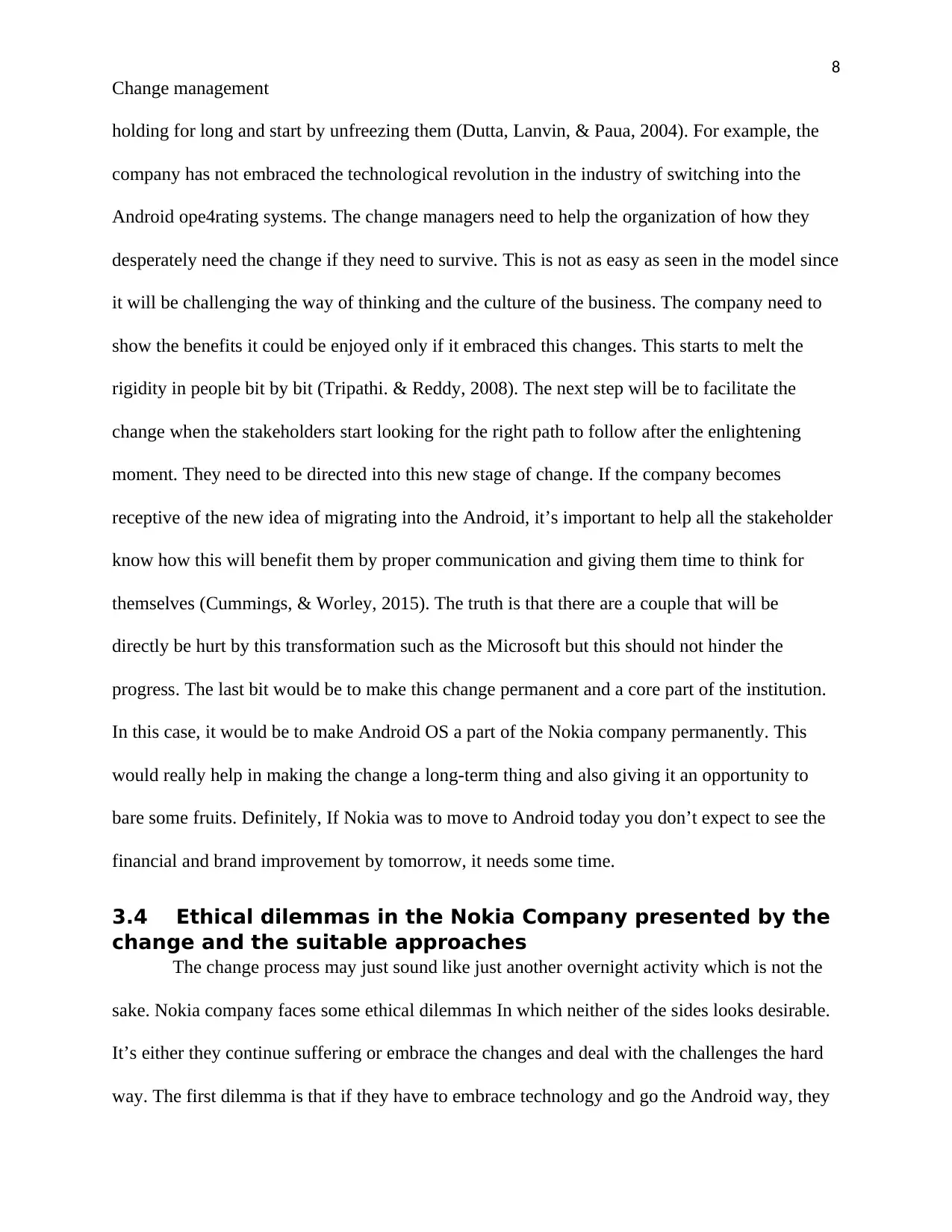
8
Change management
holding for long and start by unfreezing them (Dutta, Lanvin, & Paua, 2004). For example, the
company has not embraced the technological revolution in the industry of switching into the
Android ope4rating systems. The change managers need to help the organization of how they
desperately need the change if they need to survive. This is not as easy as seen in the model since
it will be challenging the way of thinking and the culture of the business. The company need to
show the benefits it could be enjoyed only if it embraced this changes. This starts to melt the
rigidity in people bit by bit (Tripathi. & Reddy, 2008). The next step will be to facilitate the
change when the stakeholders start looking for the right path to follow after the enlightening
moment. They need to be directed into this new stage of change. If the company becomes
receptive of the new idea of migrating into the Android, it’s important to help all the stakeholder
know how this will benefit them by proper communication and giving them time to think for
themselves (Cummings, & Worley, 2015). The truth is that there are a couple that will be
directly be hurt by this transformation such as the Microsoft but this should not hinder the
progress. The last bit would be to make this change permanent and a core part of the institution.
In this case, it would be to make Android OS a part of the Nokia company permanently. This
would really help in making the change a long-term thing and also giving it an opportunity to
bare some fruits. Definitely, If Nokia was to move to Android today you don’t expect to see the
financial and brand improvement by tomorrow, it needs some time.
3.4 Ethical dilemmas in the Nokia Company presented by the
change and the suitable approaches
The change process may just sound like just another overnight activity which is not the
sake. Nokia company faces some ethical dilemmas In which neither of the sides looks desirable.
It’s either they continue suffering or embrace the changes and deal with the challenges the hard
way. The first dilemma is that if they have to embrace technology and go the Android way, they
Change management
holding for long and start by unfreezing them (Dutta, Lanvin, & Paua, 2004). For example, the
company has not embraced the technological revolution in the industry of switching into the
Android ope4rating systems. The change managers need to help the organization of how they
desperately need the change if they need to survive. This is not as easy as seen in the model since
it will be challenging the way of thinking and the culture of the business. The company need to
show the benefits it could be enjoyed only if it embraced this changes. This starts to melt the
rigidity in people bit by bit (Tripathi. & Reddy, 2008). The next step will be to facilitate the
change when the stakeholders start looking for the right path to follow after the enlightening
moment. They need to be directed into this new stage of change. If the company becomes
receptive of the new idea of migrating into the Android, it’s important to help all the stakeholder
know how this will benefit them by proper communication and giving them time to think for
themselves (Cummings, & Worley, 2015). The truth is that there are a couple that will be
directly be hurt by this transformation such as the Microsoft but this should not hinder the
progress. The last bit would be to make this change permanent and a core part of the institution.
In this case, it would be to make Android OS a part of the Nokia company permanently. This
would really help in making the change a long-term thing and also giving it an opportunity to
bare some fruits. Definitely, If Nokia was to move to Android today you don’t expect to see the
financial and brand improvement by tomorrow, it needs some time.
3.4 Ethical dilemmas in the Nokia Company presented by the
change and the suitable approaches
The change process may just sound like just another overnight activity which is not the
sake. Nokia company faces some ethical dilemmas In which neither of the sides looks desirable.
It’s either they continue suffering or embrace the changes and deal with the challenges the hard
way. The first dilemma is that if they have to embrace technology and go the Android way, they
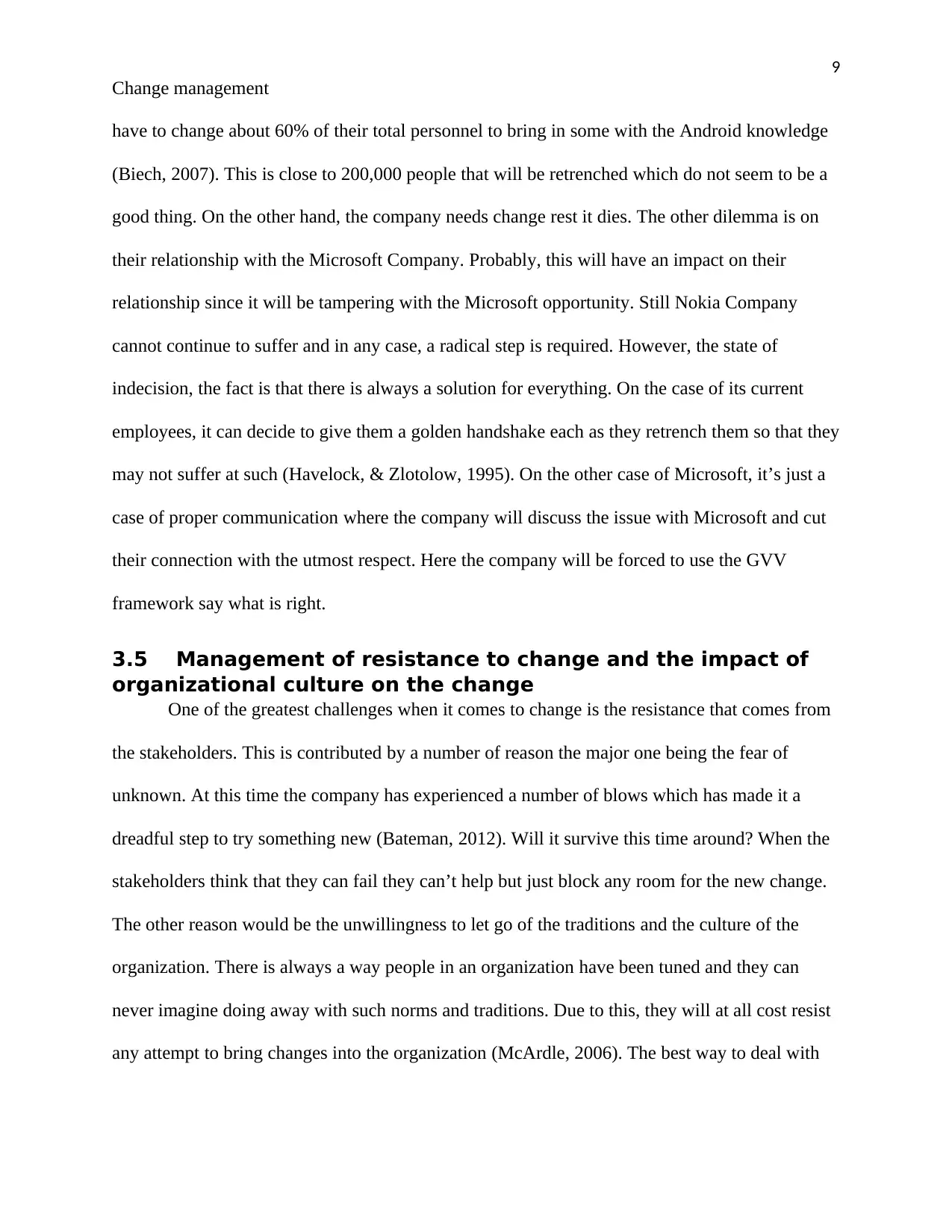
9
Change management
have to change about 60% of their total personnel to bring in some with the Android knowledge
(Biech, 2007). This is close to 200,000 people that will be retrenched which do not seem to be a
good thing. On the other hand, the company needs change rest it dies. The other dilemma is on
their relationship with the Microsoft Company. Probably, this will have an impact on their
relationship since it will be tampering with the Microsoft opportunity. Still Nokia Company
cannot continue to suffer and in any case, a radical step is required. However, the state of
indecision, the fact is that there is always a solution for everything. On the case of its current
employees, it can decide to give them a golden handshake each as they retrench them so that they
may not suffer at such (Havelock, & Zlotolow, 1995). On the other case of Microsoft, it’s just a
case of proper communication where the company will discuss the issue with Microsoft and cut
their connection with the utmost respect. Here the company will be forced to use the GVV
framework say what is right.
3.5 Management of resistance to change and the impact of
organizational culture on the change
One of the greatest challenges when it comes to change is the resistance that comes from
the stakeholders. This is contributed by a number of reason the major one being the fear of
unknown. At this time the company has experienced a number of blows which has made it a
dreadful step to try something new (Bateman, 2012). Will it survive this time around? When the
stakeholders think that they can fail they can’t help but just block any room for the new change.
The other reason would be the unwillingness to let go of the traditions and the culture of the
organization. There is always a way people in an organization have been tuned and they can
never imagine doing away with such norms and traditions. Due to this, they will at all cost resist
any attempt to bring changes into the organization (McArdle, 2006). The best way to deal with
Change management
have to change about 60% of their total personnel to bring in some with the Android knowledge
(Biech, 2007). This is close to 200,000 people that will be retrenched which do not seem to be a
good thing. On the other hand, the company needs change rest it dies. The other dilemma is on
their relationship with the Microsoft Company. Probably, this will have an impact on their
relationship since it will be tampering with the Microsoft opportunity. Still Nokia Company
cannot continue to suffer and in any case, a radical step is required. However, the state of
indecision, the fact is that there is always a solution for everything. On the case of its current
employees, it can decide to give them a golden handshake each as they retrench them so that they
may not suffer at such (Havelock, & Zlotolow, 1995). On the other case of Microsoft, it’s just a
case of proper communication where the company will discuss the issue with Microsoft and cut
their connection with the utmost respect. Here the company will be forced to use the GVV
framework say what is right.
3.5 Management of resistance to change and the impact of
organizational culture on the change
One of the greatest challenges when it comes to change is the resistance that comes from
the stakeholders. This is contributed by a number of reason the major one being the fear of
unknown. At this time the company has experienced a number of blows which has made it a
dreadful step to try something new (Bateman, 2012). Will it survive this time around? When the
stakeholders think that they can fail they can’t help but just block any room for the new change.
The other reason would be the unwillingness to let go of the traditions and the culture of the
organization. There is always a way people in an organization have been tuned and they can
never imagine doing away with such norms and traditions. Due to this, they will at all cost resist
any attempt to bring changes into the organization (McArdle, 2006). The best way to deal with
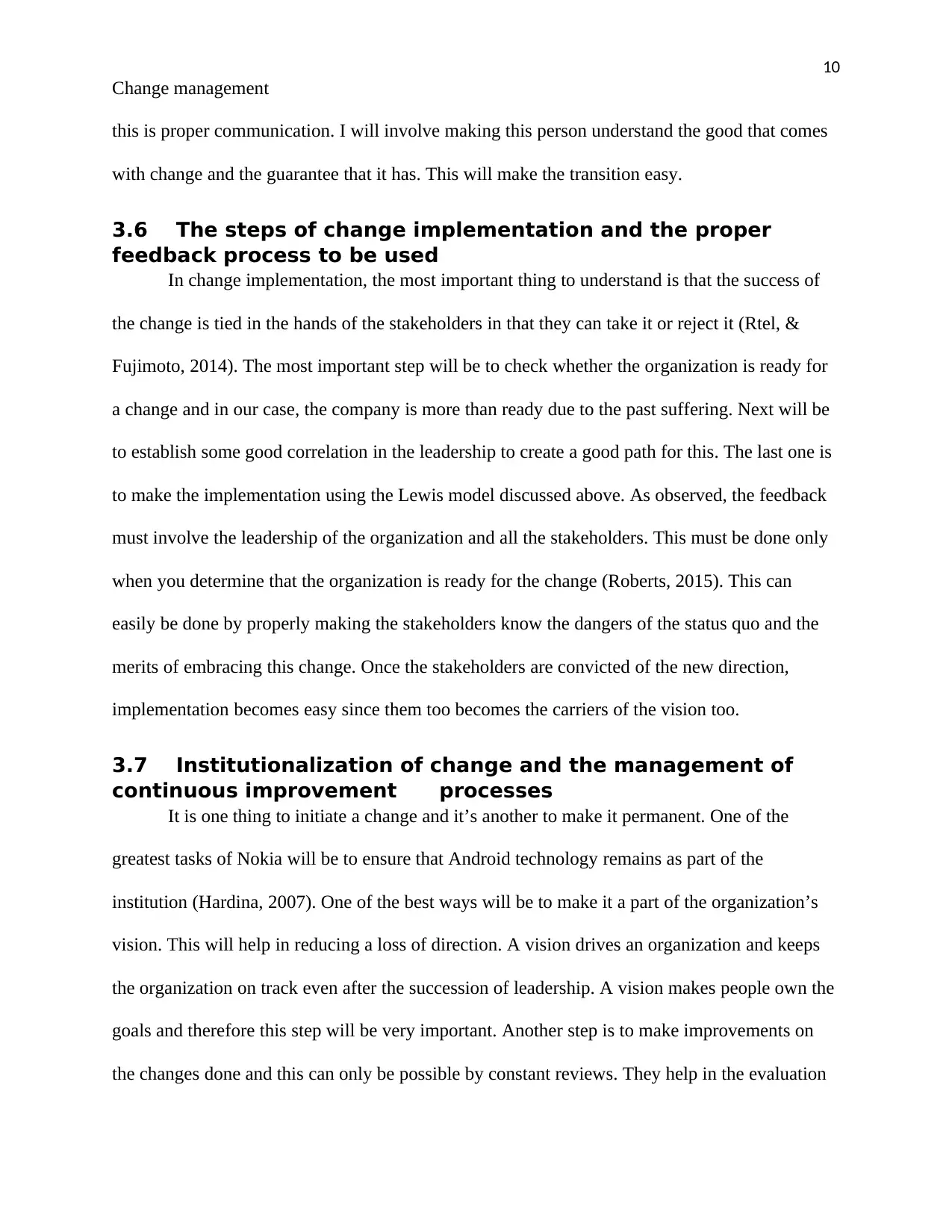
10
Change management
this is proper communication. I will involve making this person understand the good that comes
with change and the guarantee that it has. This will make the transition easy.
3.6 The steps of change implementation and the proper
feedback process to be used
In change implementation, the most important thing to understand is that the success of
the change is tied in the hands of the stakeholders in that they can take it or reject it (Rtel, &
Fujimoto, 2014). The most important step will be to check whether the organization is ready for
a change and in our case, the company is more than ready due to the past suffering. Next will be
to establish some good correlation in the leadership to create a good path for this. The last one is
to make the implementation using the Lewis model discussed above. As observed, the feedback
must involve the leadership of the organization and all the stakeholders. This must be done only
when you determine that the organization is ready for the change (Roberts, 2015). This can
easily be done by properly making the stakeholders know the dangers of the status quo and the
merits of embracing this change. Once the stakeholders are convicted of the new direction,
implementation becomes easy since them too becomes the carriers of the vision too.
3.7 Institutionalization of change and the management of
continuous improvement processes
It is one thing to initiate a change and it’s another to make it permanent. One of the
greatest tasks of Nokia will be to ensure that Android technology remains as part of the
institution (Hardina, 2007). One of the best ways will be to make it a part of the organization’s
vision. This will help in reducing a loss of direction. A vision drives an organization and keeps
the organization on track even after the succession of leadership. A vision makes people own the
goals and therefore this step will be very important. Another step is to make improvements on
the changes done and this can only be possible by constant reviews. They help in the evaluation
Change management
this is proper communication. I will involve making this person understand the good that comes
with change and the guarantee that it has. This will make the transition easy.
3.6 The steps of change implementation and the proper
feedback process to be used
In change implementation, the most important thing to understand is that the success of
the change is tied in the hands of the stakeholders in that they can take it or reject it (Rtel, &
Fujimoto, 2014). The most important step will be to check whether the organization is ready for
a change and in our case, the company is more than ready due to the past suffering. Next will be
to establish some good correlation in the leadership to create a good path for this. The last one is
to make the implementation using the Lewis model discussed above. As observed, the feedback
must involve the leadership of the organization and all the stakeholders. This must be done only
when you determine that the organization is ready for the change (Roberts, 2015). This can
easily be done by properly making the stakeholders know the dangers of the status quo and the
merits of embracing this change. Once the stakeholders are convicted of the new direction,
implementation becomes easy since them too becomes the carriers of the vision too.
3.7 Institutionalization of change and the management of
continuous improvement processes
It is one thing to initiate a change and it’s another to make it permanent. One of the
greatest tasks of Nokia will be to ensure that Android technology remains as part of the
institution (Hardina, 2007). One of the best ways will be to make it a part of the organization’s
vision. This will help in reducing a loss of direction. A vision drives an organization and keeps
the organization on track even after the succession of leadership. A vision makes people own the
goals and therefore this step will be very important. Another step is to make improvements on
the changes done and this can only be possible by constant reviews. They help in the evaluation
Paraphrase This Document
Need a fresh take? Get an instant paraphrase of this document with our AI Paraphraser
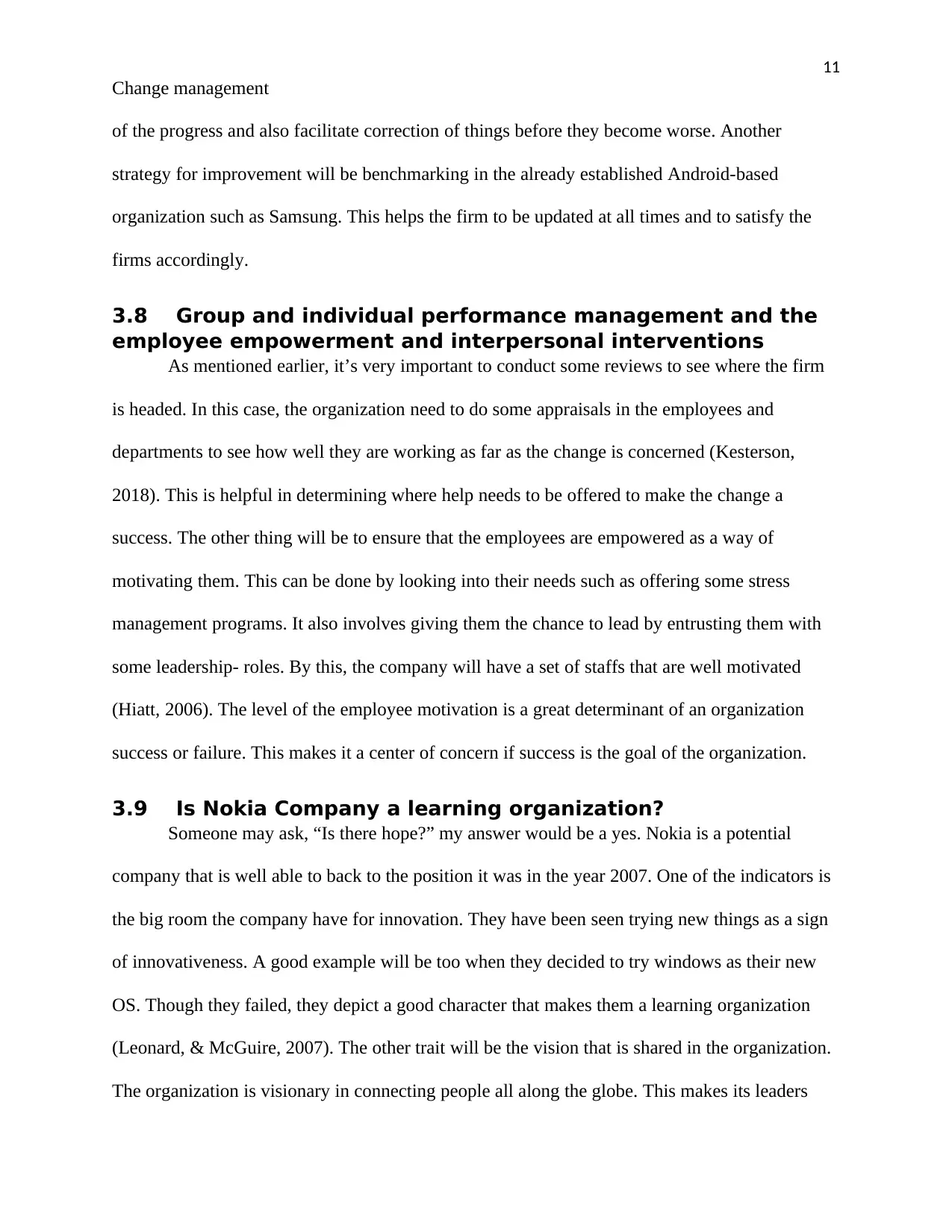
11
Change management
of the progress and also facilitate correction of things before they become worse. Another
strategy for improvement will be benchmarking in the already established Android-based
organization such as Samsung. This helps the firm to be updated at all times and to satisfy the
firms accordingly.
3.8 Group and individual performance management and the
employee empowerment and interpersonal interventions
As mentioned earlier, it’s very important to conduct some reviews to see where the firm
is headed. In this case, the organization need to do some appraisals in the employees and
departments to see how well they are working as far as the change is concerned (Kesterson,
2018). This is helpful in determining where help needs to be offered to make the change a
success. The other thing will be to ensure that the employees are empowered as a way of
motivating them. This can be done by looking into their needs such as offering some stress
management programs. It also involves giving them the chance to lead by entrusting them with
some leadership- roles. By this, the company will have a set of staffs that are well motivated
(Hiatt, 2006). The level of the employee motivation is a great determinant of an organization
success or failure. This makes it a center of concern if success is the goal of the organization.
3.9 Is Nokia Company a learning organization?
Someone may ask, “Is there hope?” my answer would be a yes. Nokia is a potential
company that is well able to back to the position it was in the year 2007. One of the indicators is
the big room the company have for innovation. They have been seen trying new things as a sign
of innovativeness. A good example will be too when they decided to try windows as their new
OS. Though they failed, they depict a good character that makes them a learning organization
(Leonard, & McGuire, 2007). The other trait will be the vision that is shared in the organization.
The organization is visionary in connecting people all along the globe. This makes its leaders
Change management
of the progress and also facilitate correction of things before they become worse. Another
strategy for improvement will be benchmarking in the already established Android-based
organization such as Samsung. This helps the firm to be updated at all times and to satisfy the
firms accordingly.
3.8 Group and individual performance management and the
employee empowerment and interpersonal interventions
As mentioned earlier, it’s very important to conduct some reviews to see where the firm
is headed. In this case, the organization need to do some appraisals in the employees and
departments to see how well they are working as far as the change is concerned (Kesterson,
2018). This is helpful in determining where help needs to be offered to make the change a
success. The other thing will be to ensure that the employees are empowered as a way of
motivating them. This can be done by looking into their needs such as offering some stress
management programs. It also involves giving them the chance to lead by entrusting them with
some leadership- roles. By this, the company will have a set of staffs that are well motivated
(Hiatt, 2006). The level of the employee motivation is a great determinant of an organization
success or failure. This makes it a center of concern if success is the goal of the organization.
3.9 Is Nokia Company a learning organization?
Someone may ask, “Is there hope?” my answer would be a yes. Nokia is a potential
company that is well able to back to the position it was in the year 2007. One of the indicators is
the big room the company have for innovation. They have been seen trying new things as a sign
of innovativeness. A good example will be too when they decided to try windows as their new
OS. Though they failed, they depict a good character that makes them a learning organization
(Leonard, & McGuire, 2007). The other trait will be the vision that is shared in the organization.
The organization is visionary in connecting people all along the globe. This makes its leaders
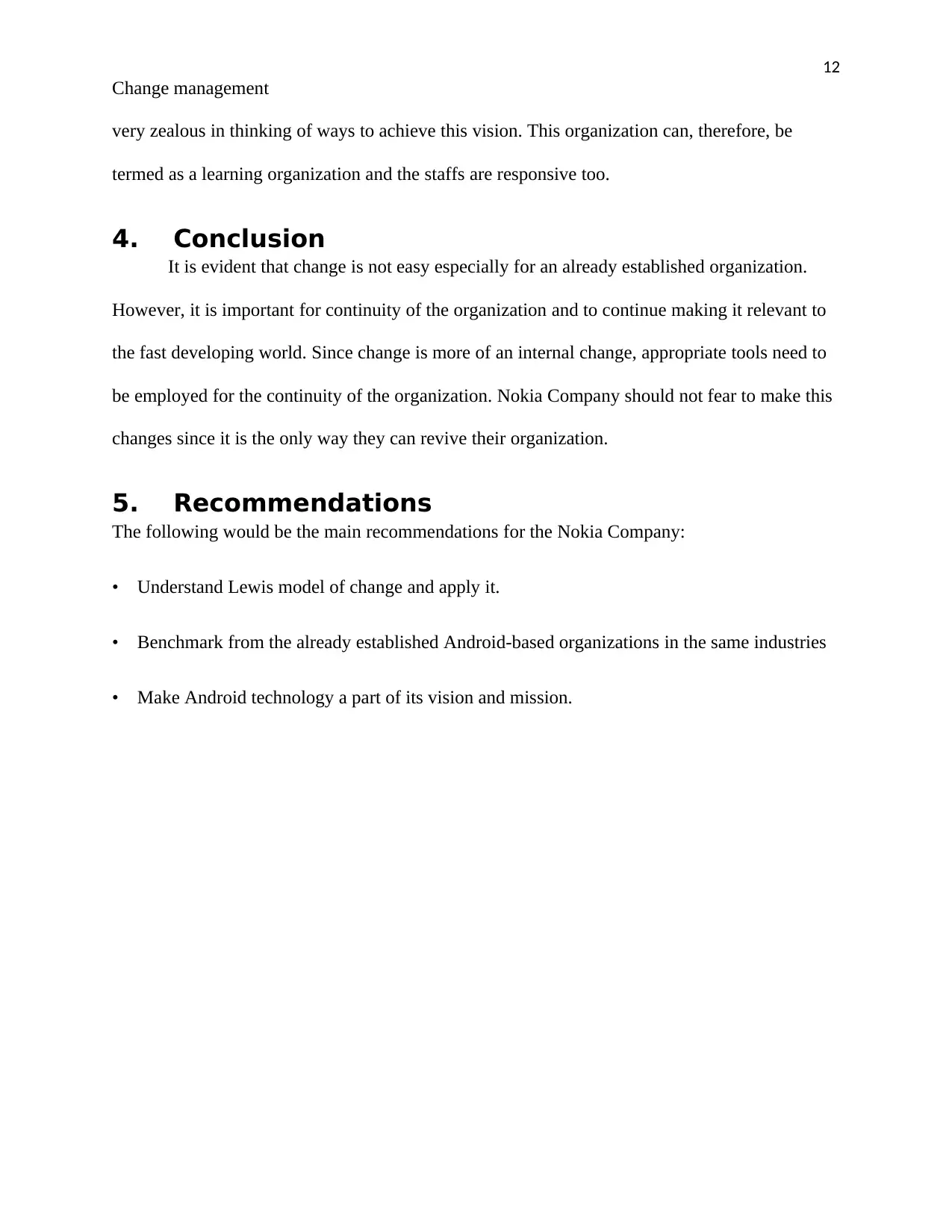
12
Change management
very zealous in thinking of ways to achieve this vision. This organization can, therefore, be
termed as a learning organization and the staffs are responsive too.
4. Conclusion
It is evident that change is not easy especially for an already established organization.
However, it is important for continuity of the organization and to continue making it relevant to
the fast developing world. Since change is more of an internal change, appropriate tools need to
be employed for the continuity of the organization. Nokia Company should not fear to make this
changes since it is the only way they can revive their organization.
5. Recommendations
The following would be the main recommendations for the Nokia Company:
• Understand Lewis model of change and apply it.
• Benchmark from the already established Android-based organizations in the same industries
• Make Android technology a part of its vision and mission.
Change management
very zealous in thinking of ways to achieve this vision. This organization can, therefore, be
termed as a learning organization and the staffs are responsive too.
4. Conclusion
It is evident that change is not easy especially for an already established organization.
However, it is important for continuity of the organization and to continue making it relevant to
the fast developing world. Since change is more of an internal change, appropriate tools need to
be employed for the continuity of the organization. Nokia Company should not fear to make this
changes since it is the only way they can revive their organization.
5. Recommendations
The following would be the main recommendations for the Nokia Company:
• Understand Lewis model of change and apply it.
• Benchmark from the already established Android-based organizations in the same industries
• Make Android technology a part of its vision and mission.
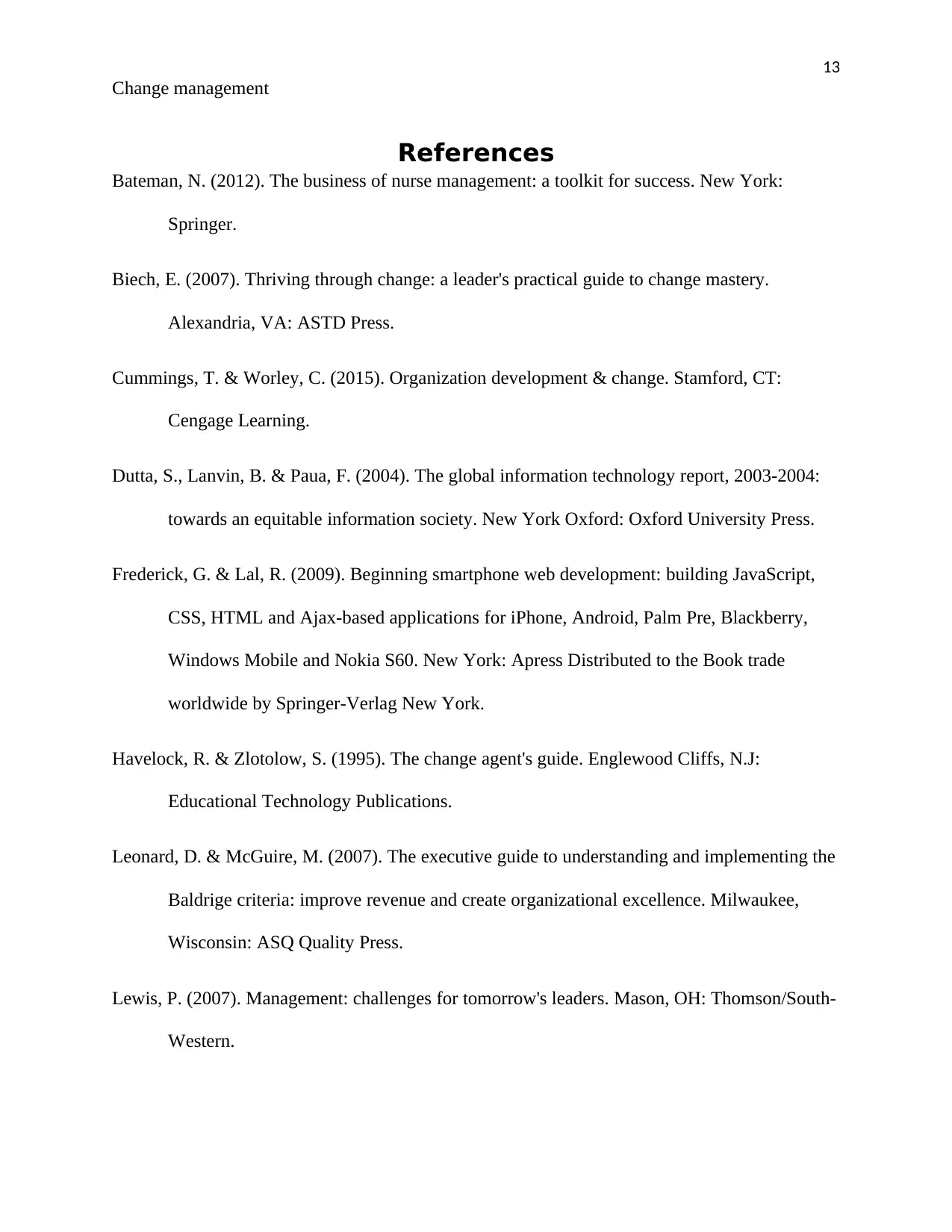
13
Change management
References
Bateman, N. (2012). The business of nurse management: a toolkit for success. New York:
Springer.
Biech, E. (2007). Thriving through change: a leader's practical guide to change mastery.
Alexandria, VA: ASTD Press.
Cummings, T. & Worley, C. (2015). Organization development & change. Stamford, CT:
Cengage Learning.
Dutta, S., Lanvin, B. & Paua, F. (2004). The global information technology report, 2003-2004:
towards an equitable information society. New York Oxford: Oxford University Press.
Frederick, G. & Lal, R. (2009). Beginning smartphone web development: building JavaScript,
CSS, HTML and Ajax-based applications for iPhone, Android, Palm Pre, Blackberry,
Windows Mobile and Nokia S60. New York: Apress Distributed to the Book trade
worldwide by Springer-Verlag New York.
Havelock, R. & Zlotolow, S. (1995). The change agent's guide. Englewood Cliffs, N.J:
Educational Technology Publications.
Leonard, D. & McGuire, M. (2007). The executive guide to understanding and implementing the
Baldrige criteria: improve revenue and create organizational excellence. Milwaukee,
Wisconsin: ASQ Quality Press.
Lewis, P. (2007). Management: challenges for tomorrow's leaders. Mason, OH: Thomson/South-
Western.
Change management
References
Bateman, N. (2012). The business of nurse management: a toolkit for success. New York:
Springer.
Biech, E. (2007). Thriving through change: a leader's practical guide to change mastery.
Alexandria, VA: ASTD Press.
Cummings, T. & Worley, C. (2015). Organization development & change. Stamford, CT:
Cengage Learning.
Dutta, S., Lanvin, B. & Paua, F. (2004). The global information technology report, 2003-2004:
towards an equitable information society. New York Oxford: Oxford University Press.
Frederick, G. & Lal, R. (2009). Beginning smartphone web development: building JavaScript,
CSS, HTML and Ajax-based applications for iPhone, Android, Palm Pre, Blackberry,
Windows Mobile and Nokia S60. New York: Apress Distributed to the Book trade
worldwide by Springer-Verlag New York.
Havelock, R. & Zlotolow, S. (1995). The change agent's guide. Englewood Cliffs, N.J:
Educational Technology Publications.
Leonard, D. & McGuire, M. (2007). The executive guide to understanding and implementing the
Baldrige criteria: improve revenue and create organizational excellence. Milwaukee,
Wisconsin: ASQ Quality Press.
Lewis, P. (2007). Management: challenges for tomorrow's leaders. Mason, OH: Thomson/South-
Western.
Secure Best Marks with AI Grader
Need help grading? Try our AI Grader for instant feedback on your assignments.
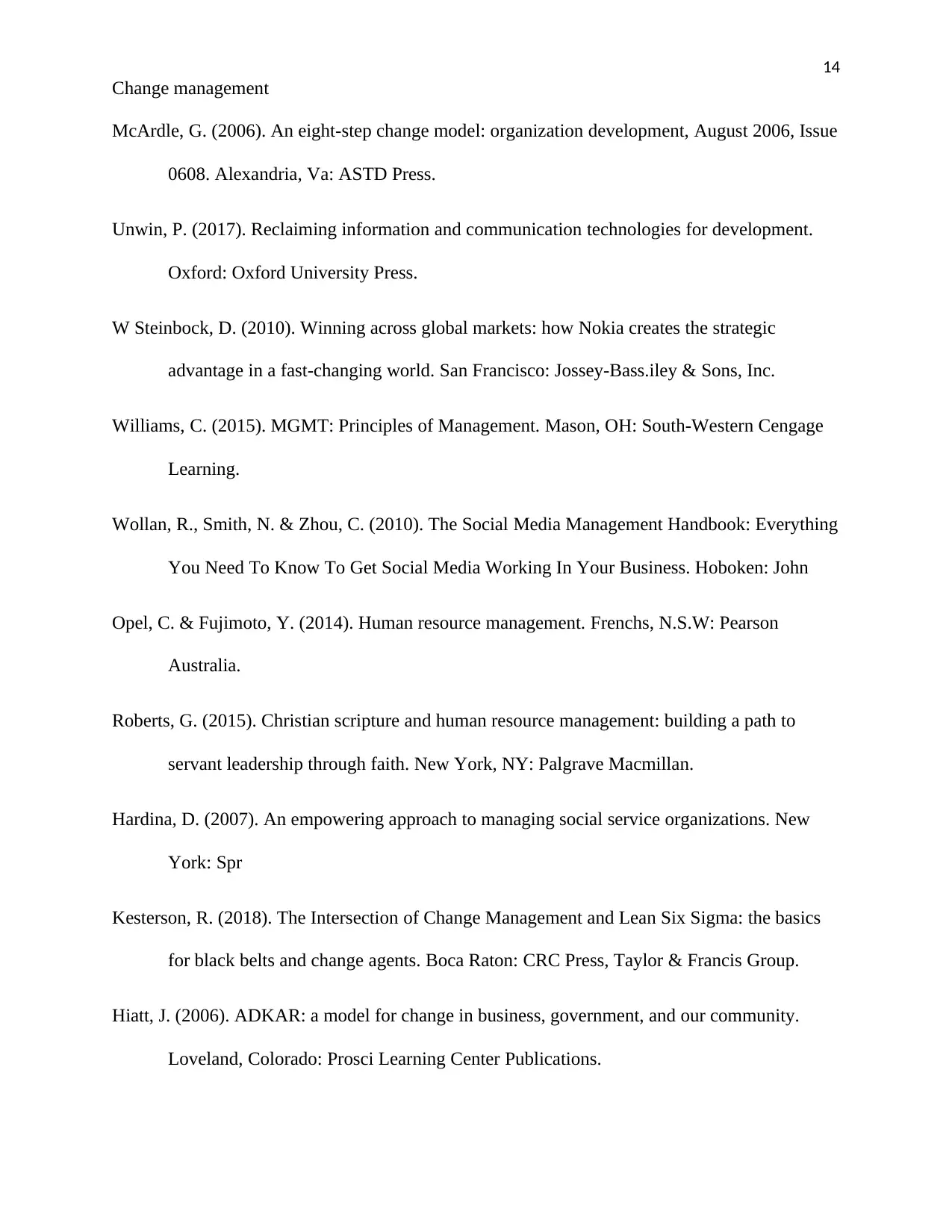
14
Change management
McArdle, G. (2006). An eight-step change model: organization development, August 2006, Issue
0608. Alexandria, Va: ASTD Press.
Unwin, P. (2017). Reclaiming information and communication technologies for development.
Oxford: Oxford University Press.
W Steinbock, D. (2010). Winning across global markets: how Nokia creates the strategic
advantage in a fast-changing world. San Francisco: Jossey-Bass.iley & Sons, Inc.
Williams, C. (2015). MGMT: Principles of Management. Mason, OH: South-Western Cengage
Learning.
Wollan, R., Smith, N. & Zhou, C. (2010). The Social Media Management Handbook: Everything
You Need To Know To Get Social Media Working In Your Business. Hoboken: John
Opel, C. & Fujimoto, Y. (2014). Human resource management. Frenchs, N.S.W: Pearson
Australia.
Roberts, G. (2015). Christian scripture and human resource management: building a path to
servant leadership through faith. New York, NY: Palgrave Macmillan.
Hardina, D. (2007). An empowering approach to managing social service organizations. New
York: Spr
Kesterson, R. (2018). The Intersection of Change Management and Lean Six Sigma: the basics
for black belts and change agents. Boca Raton: CRC Press, Taylor & Francis Group.
Hiatt, J. (2006). ADKAR: a model for change in business, government, and our community.
Loveland, Colorado: Prosci Learning Center Publications.
Change management
McArdle, G. (2006). An eight-step change model: organization development, August 2006, Issue
0608. Alexandria, Va: ASTD Press.
Unwin, P. (2017). Reclaiming information and communication technologies for development.
Oxford: Oxford University Press.
W Steinbock, D. (2010). Winning across global markets: how Nokia creates the strategic
advantage in a fast-changing world. San Francisco: Jossey-Bass.iley & Sons, Inc.
Williams, C. (2015). MGMT: Principles of Management. Mason, OH: South-Western Cengage
Learning.
Wollan, R., Smith, N. & Zhou, C. (2010). The Social Media Management Handbook: Everything
You Need To Know To Get Social Media Working In Your Business. Hoboken: John
Opel, C. & Fujimoto, Y. (2014). Human resource management. Frenchs, N.S.W: Pearson
Australia.
Roberts, G. (2015). Christian scripture and human resource management: building a path to
servant leadership through faith. New York, NY: Palgrave Macmillan.
Hardina, D. (2007). An empowering approach to managing social service organizations. New
York: Spr
Kesterson, R. (2018). The Intersection of Change Management and Lean Six Sigma: the basics
for black belts and change agents. Boca Raton: CRC Press, Taylor & Francis Group.
Hiatt, J. (2006). ADKAR: a model for change in business, government, and our community.
Loveland, Colorado: Prosci Learning Center Publications.

15
Change management
Tripathi, P. & Reddy, P. (2008). Principles of management. New Delhi: Tata McGraw-Hill Pub.
Saxena, P. (2009). Principles of management: a modern approach. New Delhi: Global India Pub.
Change management
Tripathi, P. & Reddy, P. (2008). Principles of management. New Delhi: Tata McGraw-Hill Pub.
Saxena, P. (2009). Principles of management: a modern approach. New Delhi: Global India Pub.
1 out of 15
![[object Object]](/_next/static/media/star-bottom.7253800d.svg)





